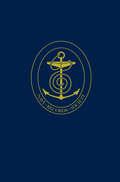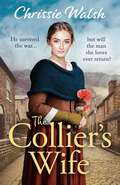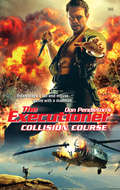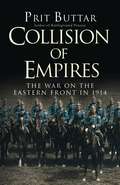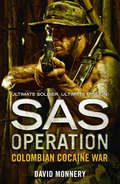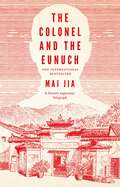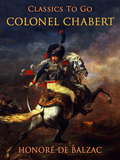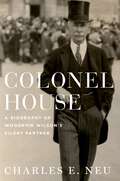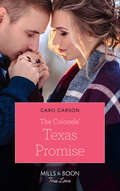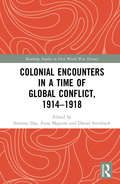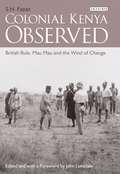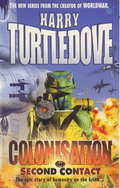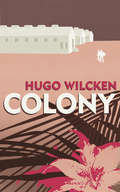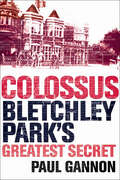- Table View
- List View
The Collective Naval Defence of Empire, 1900–1940
by Nicholas TracyThis collection of high policy documents charts Britain’s difficulties in defending the Empire in a time of ’imperial overstretch’. The 20th century saw the rise of several great maritime and military powers and the relative decline of British strength, which created major defence problems for the British Empire. Various solutions were attempted, such as ententes with France and Russia, the settling of differences with the USA and an alliance with Japan. These sufficed until after World War I, when the Empire gained several new territorial responsibilities, all to be defended on a declining economic base. The dominions were encouraged to pay for their own navies, although the Admiralty wished to assume control of them. The increasing threat from Japan made Australia, New Zealand and other Asian colonies nervous and the promised ’main fleet to Singapore’ became less and less likely as the 1930s wore on.
The Collective Naval Defence of Empire, 1900–1940
by Nicholas TracyThis collection of high policy documents charts Britain’s difficulties in defending the Empire in a time of ’imperial overstretch’. The 20th century saw the rise of several great maritime and military powers and the relative decline of British strength, which created major defence problems for the British Empire. Various solutions were attempted, such as ententes with France and Russia, the settling of differences with the USA and an alliance with Japan. These sufficed until after World War I, when the Empire gained several new territorial responsibilities, all to be defended on a declining economic base. The dominions were encouraged to pay for their own navies, although the Admiralty wished to assume control of them. The increasing threat from Japan made Australia, New Zealand and other Asian colonies nervous and the promised ’main fleet to Singapore’ became less and less likely as the 1930s wore on.
The Collier's Wife: the heartbreaking new WW1 saga
by Chrissie WalshLeeds, 1918. When Amy visits her husband Jude at Beckett's Park Hospital, he doesn't recognise her. Broken after serving four devastating years in the First World War, Jude is a shadow of the man he once was. Can he ever again be the man Amy knew and loved? Barnsborough, 1912. The first time Jude and Amy meet, the connection between them is instant and electric. While a librarian's assistant and a collier might not be the most conventional pair, the two come together over a love of books that quickly turns into more. Neither suspects their families have secrets that threaten to tear them apart... True love's path is rarely simple... but can Jude and Amy find their way back to each other? Praise for Chrissie Walsh: 'An authentic Yorkshire saga – you can almost hear the clacking of the looms. Add a feisty mill girl, determined to fight injustice, and you'll be reading through the night' Alrene Hughes on The Girl from the Mill. 'Full of joy, sorrow and a big pinch of fun. I loved it' Elizabeth Gill on The Child from the Ash Pits. 'A captivating story of family, relations and the complexities of life. With truly heart-tugging moments that make you shed a tear. The Child from the Ash Pits is everything a good read should be' Diane Allen on The Child from the Ash Pits.
Collision Course
by Don PendletonThe global trade in prohibited weapons has reached terrifying proportions. First it was illegal handguns controlled by bikers.
Collision of Empires: The War on the Eastern Front in 1914
by Prit ButtarAlthough the myriad of alliances and suspicions that existed between the Russian, German, and Austro-Hungarian empires in the early 20th century proved to be one of the primary triggers for the outbreak of the First World War, much of the actual fighting between these three nations has been largely forgotten in the West. Whilst battles such as Ypres, the Somme, and Passchendaele have been inscribed deeply on the public consciousness, with the exception of perhaps Tannenberg, the conflicts in the East do not hold the same recognition. In his new book, Prit Buttar seeks to correct this imbalance with a magisterial account of the chaos and destruction that reigned when three powerful empires collided. His harrowing narrative is driven by first-hand accounts and new, detailed archival research to create a dynamic retelling of the tumultuous events of the first year of the war, examining the battles of the Masurian Lakes and Tannenberg in East Prussia, followed by the Russo-Austrian clashes in Galicia, the failed German advance towards Warsaw, and the vicious fighting in the Carpathian mountains. Buttar reveals how delays in adapting to a modern war and inadequacies in supply and support arrangements, combined with a failure to plan for a long war, left the Central Powers struggling to keep up with events, and having to come to terms with the dreaded reality of a war on two fronts while Russia was driven towards revolution. A war that was initially seen by all three powers as a welcome opportunity to address both internal and external issues would ultimately bring about the downfall of them all.
Colombian Cocaine War (SAS Operation)
by David MonneryUltimate soldier. Ultimate mission. But will the SAS succeed in rescuing one of their own from a fearsome drug cartel?
The Colonel and the Eunuch
by Mai JiaThe phenomenal #1 Chinese bestseller, with over 3 million copies sold. This is a searing exploration of what makes a hero: a literary masterpiece, available in the English language for the very first time.The boy grows up in a small village in south China listening to stories about the Colonel: some say he was a legendary army doctor during the war, some say he was a traitor to the Party, still others say he is a wicked sex machine. The stories are bawdy and mesmerizing, always larger than life. Yet in reality, the Colonel is just a middle-aged man who loves his cat. And why on earth does everyone call him 'the Eunuch'?From these disparate sources, the boy tries to piece together who the Colonel really is, just as he himself grows up in a rapidly changing China. It is not until many years later, when the boy also becomes a middle-aged man, that he would look back and finally solve the puzzle.The Colonel and the Eunuch is Mai Jia's first new novel in eight years and his most ambitious work to date. An exciting departure from spy thrillers, this is a coming-of-age story, a family saga, as well as a searing exploration of what makes a hero. The Colonel is Mai Jia's singular creation: an almost mythic figure shrouded in the tragedy of war and history, whose story will move even the most stone-hearted to tears.
Colonel Chabert (The World At War)
by Honoré BalzacLe Colonel Chabert (English: Colonel Chabert) is an 1832 novella by French novelist and playwright Honoré de Balzac (1799–1850). It is included in his series of novels (or Roman-fleuve) known as La Comédie humaine (The Human Comedy), which depicts and parodies French society in the period of the Restoration (1815–1830) and the July Monarchy (1830–1848). This novella, originally published in Le Constitutionnel, was adapted for six different motion pictures, including two silent films. (Excerpt from Wikipedia)
Colonel House: A Biography of Woodrow Wilson's Silent Partner
by Charles E. NeuA man who lived his life mostly in the shadows, Edward M. House is little known or remembered today; yet he was one of the most influential figures of the Wilson presidency. Wilson's chief political advisor, House played a key role in international diplomacy, and had a significant hand in crafting the Fourteen Points at the Paris Peace Conference. Though the intimate friendship between the president and his advisor ultimately unraveled in the wake of these negotiations, House's role in the Wilson administration had a lasting impact on 20th century international politics. In this seminal biography, Charles E. Neu details the life of "Colonel" House, a Texas landowner who rose to become one of the century's greatest political operators. Ambitious and persuasive, House worked largely behind the scenes, developing ties of loyalty and using patronage to rally party workers behind his candidates. In 1911 he met Woodrow Wilson, and almost immediately the two formed what would become one of the most famous friendships in American political history. House became a high-level political intermediary in the Wilson administration, proving particularly adept at managing the intangible realm of human relations. After World War I erupted, House, realizing the complexity of the struggle and the dangers and opportunities it posed for the United States, began traveling to and from Europe as the president's personal representative. Eventually he helped Wilson recognize the need to devise a way to end the war that would place the United States at the center of a new world order. In this balanced account, Neu shows that while House was a resourceful and imaginative diplomat, his analysis of wartime politics was erratic. He relied too heavily on personal contacts, often exaggerating his accomplishments and missing the larger historical forces that shaped the policies of the warring powers. Ultimately, as the Paris Peace Conference unfolded, differences appeared between Wilson and his counselor. Their divergent views on the negotiations led to a bitter split, and after the president left France in June of 1919, he would never see House again. Despite this break, Neu refutes the idea that Wilson and House were antagonists. They shared the same beliefs and aspirations and were, Neu shows, part of an unusual partnership. As an organizer, tactician, and confidant, House helped to make possible Wilson's achievements, and this impressive biography restores the enigmatic counselor to his place at the center of that presidency.
Colonel House: A Biography of Woodrow Wilson's Silent Partner
by Charles E. NeuA man who lived his life mostly in the shadows, Edward M. House is little known or remembered today; yet he was one of the most influential figures of the Wilson presidency. Wilson's chief political advisor, House played a key role in international diplomacy, and had a significant hand in crafting the Fourteen Points at the Paris Peace Conference. Though the intimate friendship between the president and his advisor ultimately unraveled in the wake of these negotiations, House's role in the Wilson administration had a lasting impact on 20th century international politics. In this seminal biography, Charles E. Neu details the life of "Colonel" House, a Texas landowner who rose to become one of the century's greatest political operators. Ambitious and persuasive, House worked largely behind the scenes, developing ties of loyalty and using patronage to rally party workers behind his candidates. In 1911 he met Woodrow Wilson, and almost immediately the two formed what would become one of the most famous friendships in American political history. House became a high-level political intermediary in the Wilson administration, proving particularly adept at managing the intangible realm of human relations. After World War I erupted, House, realizing the complexity of the struggle and the dangers and opportunities it posed for the United States, began traveling to and from Europe as the president's personal representative. Eventually he helped Wilson recognize the need to devise a way to end the war that would place the United States at the center of a new world order. In this balanced account, Neu shows that while House was a resourceful and imaginative diplomat, his analysis of wartime politics was erratic. He relied too heavily on personal contacts, often exaggerating his accomplishments and missing the larger historical forces that shaped the policies of the warring powers. Ultimately, as the Paris Peace Conference unfolded, differences appeared between Wilson and his counselor. Their divergent views on the negotiations led to a bitter split, and after the president left France in June of 1919, he would never see House again. Despite this break, Neu refutes the idea that Wilson and House were antagonists. They shared the same beliefs and aspirations and were, Neu shows, part of an unusual partnership. As an organizer, tactician, and confidant, House helped to make possible Wilson's achievements, and this impressive biography restores the enigmatic counselor to his place at the center of that presidency.
The Colonels' Texas Promise (American Heroes #47)
by Caro CarsonA marriage pact, sixteen years in the making.
Colonial Encounters in a Time of Global Conflict, 1914–1918 (Routledge Studies in First World War History)
by Santanu Das Anna Maguire Daniel SteinbachThis volume gathers an international cast of scholars to examine the unprecedented range of colonial encounters during the First World War. More than four million men of color, and an even greater number of white Europeans and Americans, crisscrossed the globe. Others, in occupied areas, behind the warzone or in neutral countries, were nonetheless swept into the maelstrom. From local encounters in New Zealand, Britain and East Africa to army camps and hospitals in France and Mesopotamia, from cafes and clubs in Salonika and London, to anticolonial networks in Germany, the USA and the Dutch East Indies, this volume examines the actions and experiences of a varied company of soldiers, medics, writers, photographers, and revolutionaries to reconceptualize this conflict as a turning point in the history of global encounters. How did people interact across uneven intersections of nationality, race, gender, class, religion and language? How did encounters – direct and mediated, forced and unforced – shape issues from cross-racial intimacy and identity formation to anti-colonial networks, civil rights movements and visions of a post-war future? The twelve chapters delve into spaces and processes of encounter to explore how the conjoined realities of war, race and empire were experienced, recorded and instrumentalized.
Colonial Encounters in a Time of Global Conflict, 1914–1918 (Routledge Studies in First World War History)
by Santanu Das Anna Maguire Daniel SteinbachThis volume gathers an international cast of scholars to examine the unprecedented range of colonial encounters during the First World War. More than four million men of color, and an even greater number of white Europeans and Americans, crisscrossed the globe. Others, in occupied areas, behind the warzone or in neutral countries, were nonetheless swept into the maelstrom. From local encounters in New Zealand, Britain and East Africa to army camps and hospitals in France and Mesopotamia, from cafes and clubs in Salonika and London, to anticolonial networks in Germany, the USA and the Dutch East Indies, this volume examines the actions and experiences of a varied company of soldiers, medics, writers, photographers, and revolutionaries to reconceptualize this conflict as a turning point in the history of global encounters. How did people interact across uneven intersections of nationality, race, gender, class, religion and language? How did encounters – direct and mediated, forced and unforced – shape issues from cross-racial intimacy and identity formation to anti-colonial networks, civil rights movements and visions of a post-war future? The twelve chapters delve into spaces and processes of encounter to explore how the conjoined realities of war, race and empire were experienced, recorded and instrumentalized.
Colonial Kenya Observed: British Rule, Mau Mau and the Wind of Change
by S. H. FazanThe coast of East Africa was considered a strategically invaluable region for the establishment of trading ports, both for Arab and Persian merchants, long prior to invasion and conquest by Europeans. In the initial stages of the scramble for Africa in the 18th century, control of the area was an aspiration for every colonial nation in Europe – but it was not until 1895 that it was finally dominated by a sole power and proclaimed The Protectorate of British East Africa. In the early 20th century, the coast was brimming with vitality as immigrants, colonisers and missionaries from Arabia, India and Europe poured in to take advantage of growing commercial opportunities – including the prospect of enslaving millions of native Africans. The development of Kenya is an exceptional tale within the history of British rule – in perhaps no other colony did nationalistic feeling evolve in conditions of such extensive social and political change. In 1911, S.H. Fazan sailed to what later became the Republic of Kenya to work for the colonial government. Immersing himself in knowledge of traditional language and law, he recorded the vast changes to local culture that he encountered after decades of working with both the British administration and the Kenyan people. This work charts the sweeping tide of social change that occurred through his career with the clarity and insight that comes with a total intimacy of a country. His memoirs examine the fascinating complexity of interaction between the colonial and native courts, commercial land reform and the revolutionised dynamic of labour relations. By further unearthing the political tensions that climaxed with the Mau Mau Revolt of 1952-1960, this invaluable work on the European colonial period paints a comprehensive and revealing firsthand account for anyone with an interest in British and African history. Fazan's story provides a quite unparalleled view of colonial Africa and the conduct of Empire across half a century.
Colonial Wars, 1689-1762 (The Chicago History of American Civilization)
by Howard H. PeckhamAlthough the colonial wars consisted of almost continuous raids and skirmishes between the English and French colonists and their Indian allies and enemies, they can be separated into four major conflicts, corresponding to four European wars of which they were, in varying degrees, a part: King William's War (1689-97) (War of the League of Augsburg); Queen Anne's War (1702-13) (War of the Spanish Succession); King George's War (1744-48) (War of the Austrian Succession); and The French and Indian War (1755-62) (Seven Years' War). Mr. Peckham chronicles the events of these wars, summarizing the struggle for empire in America among France, England, and Spain. He indicates how the colonists applied the experience they gained from fighting Indians to their engagements with European powers. And what they learned from the colonial wars they translated into a political philosophy that led to independence and self-government. The ready involvement of the colonies in European ambitions, the success and failure of co-operation between colony and mother country, the efforts of the English colonies together, and the growing differences between them and Britain give the narrative continuity and rising excitement.
Colonial Wars, 1689-1762 (The Chicago History of American Civilization)
by Howard H. PeckhamAlthough the colonial wars consisted of almost continuous raids and skirmishes between the English and French colonists and their Indian allies and enemies, they can be separated into four major conflicts, corresponding to four European wars of which they were, in varying degrees, a part: King William's War (1689-97) (War of the League of Augsburg); Queen Anne's War (1702-13) (War of the Spanish Succession); King George's War (1744-48) (War of the Austrian Succession); and The French and Indian War (1755-62) (Seven Years' War). Mr. Peckham chronicles the events of these wars, summarizing the struggle for empire in America among France, England, and Spain. He indicates how the colonists applied the experience they gained from fighting Indians to their engagements with European powers. And what they learned from the colonial wars they translated into a political philosophy that led to independence and self-government. The ready involvement of the colonies in European ambitions, the success and failure of co-operation between colony and mother country, the efforts of the English colonies together, and the growing differences between them and Britain give the narrative continuity and rising excitement.
Colonial Wars, 1689-1762 (The Chicago History of American Civilization)
by Howard H. PeckhamAlthough the colonial wars consisted of almost continuous raids and skirmishes between the English and French colonists and their Indian allies and enemies, they can be separated into four major conflicts, corresponding to four European wars of which they were, in varying degrees, a part: King William's War (1689-97) (War of the League of Augsburg); Queen Anne's War (1702-13) (War of the Spanish Succession); King George's War (1744-48) (War of the Austrian Succession); and The French and Indian War (1755-62) (Seven Years' War). Mr. Peckham chronicles the events of these wars, summarizing the struggle for empire in America among France, England, and Spain. He indicates how the colonists applied the experience they gained from fighting Indians to their engagements with European powers. And what they learned from the colonial wars they translated into a political philosophy that led to independence and self-government. The ready involvement of the colonies in European ambitions, the success and failure of co-operation between colony and mother country, the efforts of the English colonies together, and the growing differences between them and Britain give the narrative continuity and rising excitement.
Colonial Wars, 1689-1762 (The Chicago History of American Civilization)
by Howard H. PeckhamAlthough the colonial wars consisted of almost continuous raids and skirmishes between the English and French colonists and their Indian allies and enemies, they can be separated into four major conflicts, corresponding to four European wars of which they were, in varying degrees, a part: King William's War (1689-97) (War of the League of Augsburg); Queen Anne's War (1702-13) (War of the Spanish Succession); King George's War (1744-48) (War of the Austrian Succession); and The French and Indian War (1755-62) (Seven Years' War). Mr. Peckham chronicles the events of these wars, summarizing the struggle for empire in America among France, England, and Spain. He indicates how the colonists applied the experience they gained from fighting Indians to their engagements with European powers. And what they learned from the colonial wars they translated into a political philosophy that led to independence and self-government. The ready involvement of the colonies in European ambitions, the success and failure of co-operation between colony and mother country, the efforts of the English colonies together, and the growing differences between them and Britain give the narrative continuity and rising excitement.
Colonisation: Second Contact (Colonisation Ser. #Bk. 1)
by Harry TurtledoveHalfway through World War II aliens invaded Earth. They were repelled - but now, years later they are back . . . This is the first volume in the three-part Colonisation series, which follows the Worldwar trilogy. The whole sequence will conclude with Homeward Bound.Through a mixture of guts, ingenuity and sheer luck, Earth managed to defend herself from her ruthless alien would-be conquerors. The 'Race' was fought to a bloody standstill despite its awe-inspiring weaponry and experience of merciless conquest. Thousands died from enemy fire, many more from the smouldering nuclear-scarred fall-out sites. An uneasy ceasefire reigns over this divided globe, as both sides strive to test their strength through more subtle techniques. But now, years later, this delicate equilibrium has been shattered. For the first assault was only an advance. guard.Now, a whole new fleet orbits the planet. The real colonists have arrived, fresh and unwill to accept old compromises. 'The wizard of If.' Chicago Sun-Times 'Turtledove the standard bearer for alternate history.' USA Today
Colony
by Hugo WilckenFrom the author of the existential thriller ‘The Execution’ comes ‘Colony’, a novel set in French Guiana as the age of Empire draws to a close and anarchy beckons.
Colorado Women in World War II (Timberline Books)
by Gail M. BeatonFour months before the attack on Pearl Harbor on December 7, 1941, Mildred McClellan Melville, a member of the Denver Woman’s Press Club, predicted that war would come for the United States and that its long arm would reach into the lives of all Americans. And reach it did. Colorado women from every corner of the state enlisted in the military, joined the workforce, and volunteered on the home front. As military women, they served as nurses and in hundreds of noncombat positions. In defense plants they riveted steel, made bullets, inspected bombs, operated cranes, and stored projectiles. They hosted USO canteens, nursed in civilian hospitals, donated blood, drove Red Cross vehicles, and led scrap drives; and they processed hundreds of thousands of forms and reports. Whether or not they worked outside the home, they wholeheartedly participated in a kaleidoscope of activities to support the war effort. In Colorado Women in World War II Gail M. Beaton interweaves nearly eighty oral histories—including interviews, historical studies, newspaper accounts, and organizational records—and historical photographs (many from the interviewees themselves) to shed light on women’s participation in the war, exploring the dangers and triumphs they felt, the nature of their work, and the lasting ways in which the war influenced their lives. Beaton offers a new perspective on World War II—views from field hospitals, small steel companies, ammunition plants, college classrooms, and sugar beet fields—giving a rare look at how the war profoundly transformed the women of this state and will be a compelling new resource for readers, scholars, and students interested in Colorado history and women’s roles in World War II.
Colossus: Bletchley Park's Greatest Secret
by Paul GannonThis is the last untold story of Bletchley Park. Using declassified information, Paul Gannon gives us a gripping account of the invention of the world's first true computer, Colossus.Uncover the secrets of Bletchley Park's code-breaking computers.In 1940, almost a year after the outbreak of the Second World war, Allied radio operators at an interception station in South London began picking up messages in a strange new code. Using science, maths, innovation and improvisation Bletchley Park codebreakers worked furiously to invent a machine to decipher what turned out to be the secrets of Nazi high command. It was called Colossus.What these codebreakers didn't realize was that they had to fashion the world's first true computer. When the war ended, this incredible invention was dismantled and hidden away for almost 50 years. Paul Gannon has pieced together the tremendous story of what is now recognized as the greatest secret of Bletchley Park.'Gannon's book contains a mass of utterly fascinating and largely unknown material about an immensely important wartime project, and is very welcome indeed.' - Brian Rendell, TES
The Colours
by Juliet BatesEllen sees the world differently from everyone else, but living in a tiny town in the north-east of England, in a world on the cusp of war, no one has time for an orphaned girl who seems a little strange. When she is taken in to look after a rich, elderly widow all seems to be going better, despite the musty curtains and her aging employer completely out of touch with the world. But pregnancy out of wedlock spoils all this, and Ellen is unable to cope. How will Jack, her son, survive - alone in the world as his mother was? Can they eventually find their way back to each other?The Colours is a sweeping novel of how we can lose ourselves, and our loved ones, for fans of Kate Atkinson and Virginia Baily.
The Colt 1911 Pistol (Weapon)
by Peter Dennis Leroy Thompson Alan GillilandFirst used in combat during the Punitive Expedition into Mexico and then extensively during the world wars, the Colt Government Model (1911) pistol remained the standard issue handgun in the US armed forces for nearly 80 years and has continued in service with some units to this day. In fact, the M1911 has seen a resurgence amongst US Special Operations units as US Marine MARSOC and MEUSOC personnel are issued current generation 1911-type pistols. In addition the pistol has seen service with famous law enforcement agencies such as the Shanghai Municipal Police, LAPD Swat and Texas Rangers. Nearly a century after its introduction, the M1911 pistol remains a popular design and is now produced by virtually every major firearms manufacturer doing business in the USA.
